Affiliate disclosure: This post may contain affiliate links. Please see our Privacy Policy.
Acorn coffee is a fun way to enjoy a wild harvest of acorns, and it has been used as a coffee substitute all over the world in times of war and famine. You’d be amazed at how far a warm beverage can take you, transporting you outside of the conflict with a bit of familiar flavor, to bring back the memories and nostalgia of a better time. Even outside of dire circumstances, it’s actually surprisingly good and tastes a lot like real coffee, but without the caffeine.
Learn how to make your own acorn coffee as a fun project, and you’ll have one more way to enjoy and connect with the natural world around you.

Acorns have been used as a food source around the world for millennia.
While these days acorn recipes are mostly associated with Native Americans, they were a part of the traditional food supply in Greece, Italy, Spain, North Africa and throughout Asia. Oaks continue to produce abundant nutrition for humankind, even if we’ve largely forgotten how to harvest and prepare this free food source.
Acorn coffee, or a coffee substitute made from wild foraged acorns that have been leached and roasted was common all the way through WWII. In times of famine, war or just as a result of poverty, people sought comfort in a familiar flavor. Though they had no way to get real coffee, they could get the taste anywhere oak trees grew.
These days, it’s more common that people are actively choosing acorn coffee (rather than resorting to it). As people seek out the ritual of a coffee date or a morning cup of joe, they can do it without actually having caffeine.
I’m going to take you through all the steps required to make acorn coffee on your own with wild foraged acorns. If you’re just looking to try it without all the work, there are a few places that sell acorn coffee online.
How to Make Acorn Coffee
The basic steps to making acorn coffee are pretty simple. In a nutshell, the process includes:
- Find and harvest acorns (any variety)
- Clean and sort the acorns, removing spoiled or bug infested ones
- Crack the acorns to remove the shell and extract the nut meat
- Leach the acorns to remove tannin (not optional)
- Roast the leached acorns to dry and toast them
- Grind the roasted acorns
- Brew coffee as you otherwise would with the ground acorn “coffee grounds”
The first step is sourcing acorns from a clean, natural environment. Avoid oak trees near roads or contaminated areas that might have runoff from roads or any other nastiness. You’re going to be drinking this, so it should come from either a clean, un-sprayed backyard or an unspoiled woodland.
The type of acorn doesn’t really matter, believe it or not. Some people say that white oaks produce “sweet” acorns that have less tannins, but that’s not technically true. They just tend to have tannins that are less detectable by human palates, but are just as bad for our digestive system. All acorns will need to be leached of tannins before you actually brew acorn coffee, so it doesn’t matter what oak species you use.
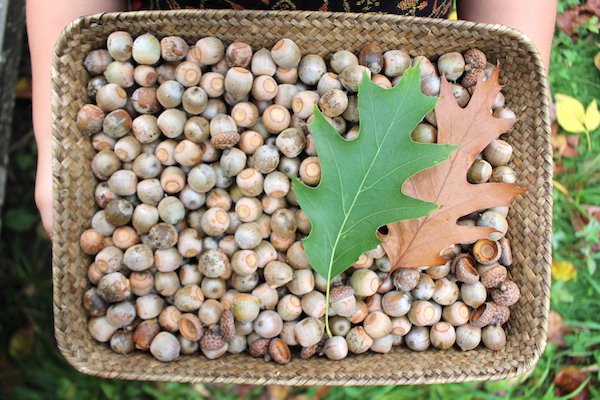
Next, clean and sort the acorns to remove any that are:
- Green and unripe
- Have spoilage or mold
- Have holes that indicate worm damage inside
Acorns are really plentiful, and you don’t really need very many to make acorn coffee, so it should be easy enough to find a few cups of really clean acorns.
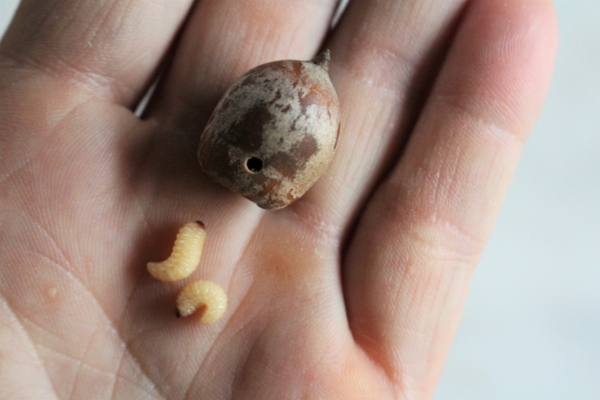
After cleaning and sorting, it’s time to crack the acorns. The outside of the nut has a hard shell, like all nuts, but it’s easier to crack than many species of wild nut. With black walnuts and butternuts, you need a specialized nut cracker, but with acorns, a simple hammer will do (though a nutcracker would work nicely too).
Set the acorn up and give it a gentle whack with a hammer, being careful to avoid your fingers.
I actually find it works best to put the acorn pointy side down into a cutting board or log, where it’ll make a little divot when you crack it. That divot from the point of the acorn will help hold all the acorns that come after it, and make crackling them much easier. (Again, watch your fingers here…)
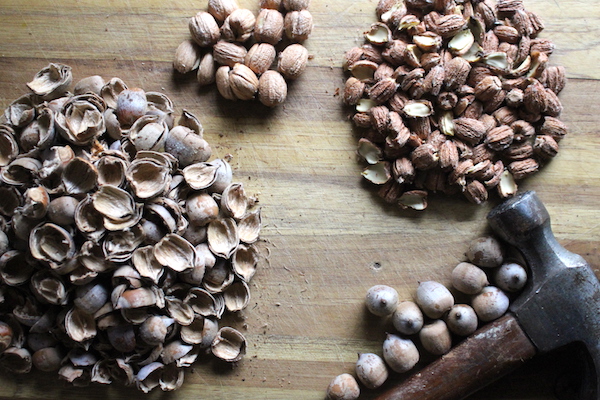
Once you’ve cracked the acorns, the next step is boiling the nut meats to extract the tannins in a “hot water extraction.”
When you’re making acorn flour, most people opt to do a cold water extraction because it doesn’t cook the starches in the acorns, which will allow them to still work in baked goods (like acorn flour cookies and acorn pancakes). For acorn coffee, however, you don’t want that starch in there to bind to things and gum things up. A hot extraction is faster, and most people opt for that.
Still, if you’re short on fuel, feel free to do a cold extraction and just leave the nut meats submerged in cold water for 7 to 14 days, decanting off the water daily and replacing it with clean water (full instructions in my acorn flour article). The nut meats will be roasted anyway, which gives them flavor and makes them dry enough to be ground into acorn coffee, so either way they’ll be cooked before being ground (so no starch concerns).
To hot leach the tannins from the acorn nut meats, place them in a pot of water and bring them to a boil. Cook for 20-30 minutes, then drain the water. Refill the pot and start over.
You should plan to do at least 2 water changes, and then start taste testing your acorns. Just a tiny nibble.
When they no longer taste tannic and make your mouth feel dry, you can stop the leaching process, but otherwise keep boiling with water changes until they’re just neutral flavored. The total time will depend on your acorns, their growing conditions and the exact species. Tannin content can vary dramatically by acorn type.
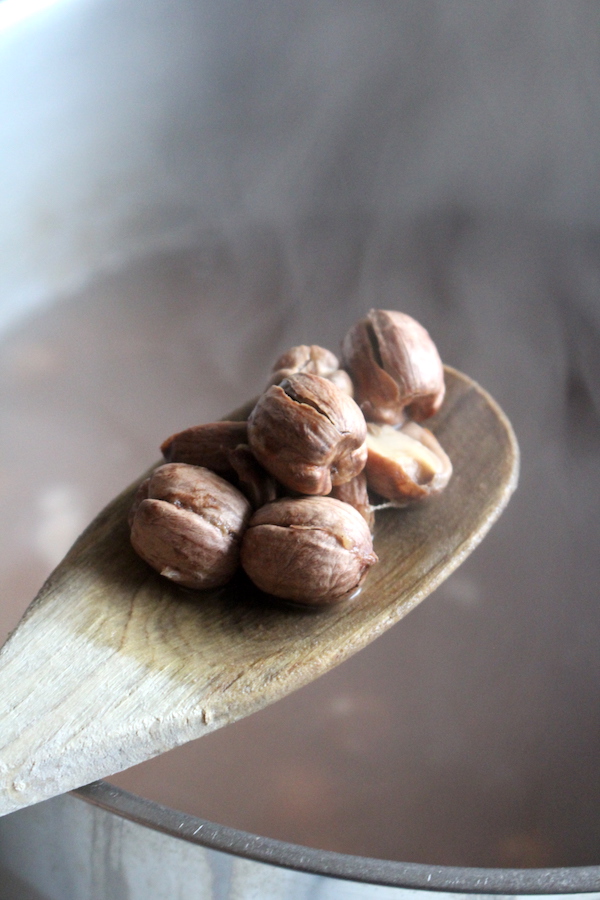
Once the acorns have been leached of their tannins, they should taste a bit like cooked beans (with no tannic aftertaste). Some people use them like this to make vegan acorn burgers or a type of acorn hummus, but we’re going to press on and turn them into a fresh roasted acorn coffee.
The leached acorns now need to be dried out and toasted so they’ll grind properly, but also to give them flavor. Unroasted green coffee beans don’t taste great, and it’s the roasting process that brings out a lot of the natural flavors. If you’re curious how this works, you can get green coffee beans and try roasting your own coffee in a cast iron skillet on the stove. (You know, like the cowboys did a century ago.)
The roast will greatly affect the finished taste, from a light blond roast all the way up to a dark roast.
It’s also true with making acorn coffee, but to a lesser extent. Obviously don’t burn them, because that’ll taste like charcoal. You’re going for a nice deep roast, with a good snap when you break them in half. They shouldn’t be wet at all in the center after roasting. Any moisture will cause them to spoil, won’t let them grind properly and is a sign of under roasting.
I’d suggest roasting them at 400 degrees F for about 30 to 45 minutes. I pulled mine out after 40 minutes, and they’re a nice shade of chocolate brown, and they snap in half easily.
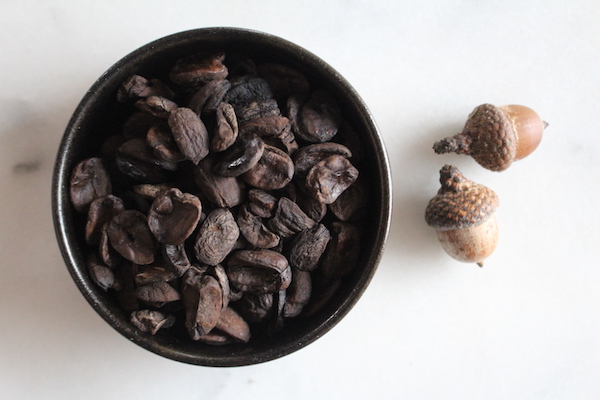
Your next step is grinding the roasted acorn meats so you can use them for coffee.
Use whatever grind setting you use for coffee. I’m making french roast here, so I went with a pretty coarse grind in my hand crank coffee grinder. I’ve also tried it using a percolator over a campfire and a moka pot on a camp stove. They all work just fine.
At this point, the grounds should look exactly like coffee grounds, and the resulting coffee tastes pretty darn similar too (but without the caffeine).
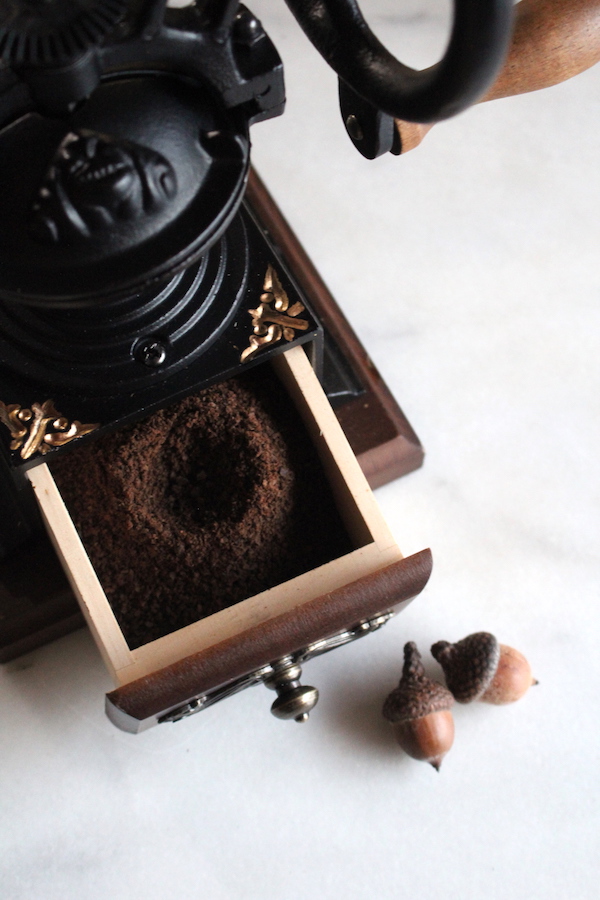
To brew a cup of acorn coffee with these grounds, you can use whatever method you generally use for your coffee (or use a tea strainer too).
The amount to use is going to vary based on your personal taste, but I’ve found that you need a bit more than you generally use for your homemade coffee. With regular coffee, they say you need around 2 tablespoons of regular coffee grounds per cup. I found that I wanted more like 3 or 4 tablespoons of acorn coffee per cup.
In the end, your cup of acorn coffee is going to taste a bit lighter than regular coffee, and less acidic. It’s much easier to drink black than regular coffee, so try it that way before you add your customary cream or sugar.
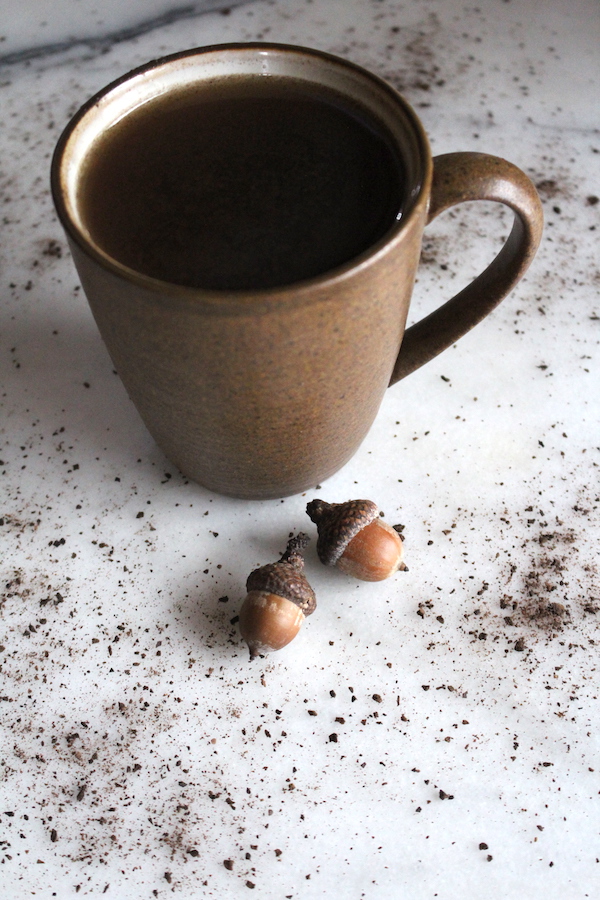
Even if you never make acorn coffee, it’s kind of fun to know that you can, and that people all over the world have used acorns as a coffee substitute in a pinch.
Foraged Food Recipes
Looking for more wild recipes? Read on…
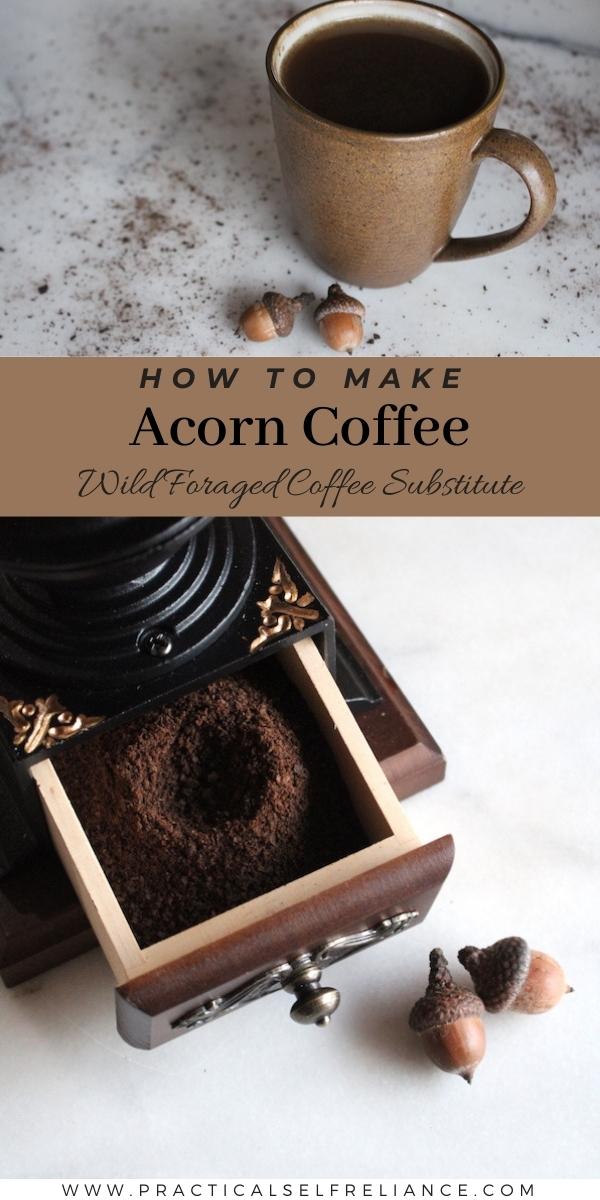




Can I just say I just learned something new and can’t wait to try it in a a few weeks!! It’s almost Acorn season in the Carolinas!!! Thanks for this post!!!
You’re very welcome. Let us know how you like it.
Yeah, but… Caffeine?!?
I know, right! There really isn’t caffeine in anything that grows wild in the US, at least not in any appreciable amount. Cleavers (a common weed) is related to coffee and does have a VERY small amount of caffeine, but it’s not enough to really feel any effect (though it’s also made into a herbal coffee substitute). I think if there’s no coffee, you’re pretty much out of luck on caffeine in the wild (which is sad for me to).